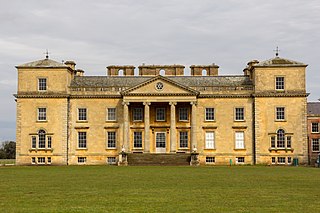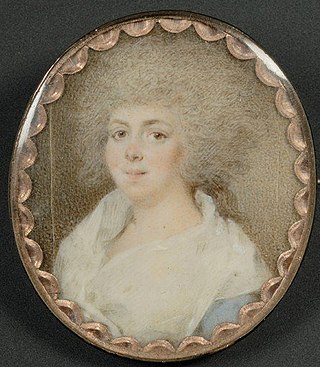
Mount Vernon is the former plantation of Founding Father, commander of the Continental Army in the Revolutionary War, and the first president of the United States George Washington and his wife, Martha. An American landmark, the estate lies on the banks of the Potomac River in Fairfax County, Virginia. It is located south of Washington, D.C., and Alexandria, Virginia, and is across the river from Prince George's County, Maryland.

The Thousand Islands constitute a North American archipelago of 1,864 islands that straddles the Canada–US border in the Saint Lawrence River as it emerges from the northeast corner of Lake Ontario. They stretch for about 50 miles (80 km) downstream from Kingston, Ontario. The Canadian islands are in the province of Ontario and the U.S. islands in the state of New York.

Brockville, formerly Elizabethtown, is a city in Eastern Ontario, Canada, in the Thousand Islands region. Although it is the seat of the United Counties of Leeds and Grenville, it is politically independent of the county. It is included with Leeds and Grenville for census purposes only.

Spadina Museum, also known as Spadina House, is a historic mansion at 285 Spadina Road in Toronto, Ontario, which is now a historic house museum operated by the City of Toronto's Economic Development & Culture division. The museum preserves the house much as it existed and developed historically. The art, decor and architecture of the house used to reflect the contemporary styles of the 1860s through the 1930s, including Victorian, Edwardian, Arts and Crafts, Art Nouveau, Art Deco and Colonial Revival styles. The museum closed for a year for extensive interior and exterior renovations. When it re-opened to the public on October 24, 2010, it was decorated in the style of the inter-war era of the 1920s and 1930s. The estate's gardens reflect the landscape during the Austin family's occupation of the house.

Biltmore Estate is a historic house museum and tourist attraction in Asheville, North Carolina. Biltmore House, the main residence, is a Châteauesque-style mansion built for George Washington Vanderbilt II between 1889 and 1895 and is the largest privately owned house in the United States, at 178,926 sq ft (16,622.8 m2) of floor space. Still owned by George Vanderbilt's descendants, it remains one of the most prominent examples of Gilded Age mansions.

Elizabethtown-Kitley is a township in eastern Ontario, Canada, in the United Counties of Leeds and Grenville. Its southern border lies along the St. Lawrence River and it extends north into many rural hamlets and villages. The township was created on January 1, 2001 by the amalgamation of the former Township of Elizabethtown and Township of Kitley.

Osterley Park and House is a Georgian country estate in west London, that straddles the London boroughs of Ealing and Hounslow. Originally dating from the 1570s, the estate contains a number of Grade I and II listed buildings, with the park listed as Grade II*. The main house was remodelled by Robert Adam between 1761 and 1765. The National Trust took charge of Osterley in 1991 and the house and park are open to visitors.

The Home of Franklin D. Roosevelt National Historic Site preserves the Springwood estate in Hyde Park, New York, United States. Springwood was the birthplace, lifelong home, and burial place of the 32nd president of the United States, Franklin D. Roosevelt. Eleanor Roosevelt is buried alongside him. The National Historic Site was established in 1945.
Horaceville is a historic site located on the Ottawa River in eastern Ontario, Canada. The site remained the property of the heirs of Hamnett Kirkes Pinhey until the 1970s, when the property was sold to the township. Today, The 88-acre (360,000 m2) heritage site is owned and operated by the City of Ottawa and Pinhey's home serves as a museum. The museum is open May 14 through August 31, Wednesdays to Sundays, 11 am to 5 pm. This location is also known as Pinhey's Point Historic Site. The property was designated by the City of Ottawa under Part IV of the Ontario Heritage Act as having cultural heritage value or interest. A bronze plaque erected on the site by the Ontario Heritage Foundation describes the property's history: "Hamnet Kirkes Pinhey 1784 - 1857 - A merchant and ship owner in his native England, Pinhey came to Upper Canada in 1820. For his services as King's messenger during the Napoleonic Wars, he received a 1000 acres land grant on the Ottawa River. Within a decade he had built up an estate which he named Horaceville after his elder son. In addition to a manor house and barns, it included mills, a store and church. Pinhey took a leading part in township and district affairs. He was appointed to the Legislative Council in 1847, served as Warden of the Dalhousie District, and as the first Warden of Carleton County. Horaceville remained in family hands until 1959 when it was purchased by the National Capital Commission."

The Ontario Heritage Trust is a non-profit agency of the Ontario Ministry of Tourism and Culture. It is responsible for protecting, preserving and promoting the built, natural and cultural heritage of Canada's most populous province, Ontario.

George Washington Parke Custis was an American plantation owner, antiquarian, author, and playwright. His father John Parke Custis was the stepson of George Washington. He and his sister Eleanor grew up at Mount Vernon and in the Washington presidential household.

Dr. Williams' Pink Pills for Pale People was a late 19th to early 20th-century patent medicine containing ferrous sulfate and magnesium sulfate. It was produced by Dr. Williams Medicine Company, the trading arm of G. T. Fulford & Company. It was claimed to cure chorea, referenced frequently in newspaper headlines as "St. Vitus' Dance"; as well as "locomotor ataxia, partial paralyxia, seistica, neuralgia rheumatism, nervous headache, the after-effects of la grippe, palpitation of the heart, pale and sallow complexions, [and] all forms of weakness in male or female."

George Taylor Fulford was a Canadian businessman and politician.

Hatley Park National Historic Site is located in Colwood, British Columbia, in Greater Victoria. It is the site of Hatley Castle, a Classified Federal Heritage Building. Since 1995, the mansion and estate have been used for the public Royal Roads University. From the 1940s to 1995, it was used for the Royal Roads Military College, a naval training facility.

Brucemore, a park-like, 26-acre (110,000 m2) estate in the heart of Cedar Rapids, Iowa, is the site of a Queen Anne-style mansion, formal gardens, a children's garden, night garden, pond, orchard, and woodland. Built between 1884 and 1886 by Caroline Sinclair, widow of pioneer industrialist T.M. Sinclair, Brucemore has been home to three prominent families who used the estate as a center for culture and the arts. Brucemore, whose name alludes to the Scottish moors of the second owner's ancestral home, is Iowa's only National Trust Historic Site and is preserved by the National Trust for Historic Preservation in co-stewardship with Brucemore, Inc. Under the name of the T.M. Sinclair Mansion, it is listed on the National Register of Historic Places. The mansion has three stories, and contains twenty-one rooms. Distinctive features include a steeply gabled roof, five chimneys, and several turrets.

Croome Court is a mid-18th-century Neo-Palladian mansion surrounded by extensive landscaped parkland at Croome D'Abitot, near Upton-upon-Severn in south Worcestershire, England. The mansion and park were designed by Lancelot "Capability" Brown for the 6th Earl of Coventry, and they were Brown's first landscape design and first major architectural project. Some of the mansion's rooms were designed by Robert Adam. St Mary Magdalene's Church, Croome D'Abitot that sits within the grounds of the park is now owned and cared for by the Churches Conservation Trust.

Liberty Hall, also known as the Governor William Livingston House, located on Morris Avenue in Union, Union County, New Jersey, United States, is a historic home where many leading influential people lived. It was documented by the Historic American Buildings Survey (HABS) in 1938. The house was added to the National Register of Historic Places as a National Historic Landmark on November 28, 1972, for its significance in politics and government. It is now the Liberty Hall Museum.

The Cangarda is a 126-foot (38 m) long luxury steam yacht that was built in 1901 at the Pusey and Jones shipyard in Wilmington, Delaware. It is the only surviving U.S.-built steel steam yacht and one of only three similar yachts remaining worldwide.

Eleanor Calvert Custis Stuart, born Eleanor Calvert, was a prominent member of the wealthy Calvert family of Maryland. Upon her marriage to John Parke Custis, she became the daughter-in-law of Martha Dandridge Custis Washington and the step-daughter-in-law of George Washington. Her portrait hangs today at Mount Airy Mansion in Rosaryville State Park, Maryland.
George Taylor Fulford was a Canadian businessman and politician who served as a Liberal party member of the House of Commons of Canada. Fulford was born in Brockville, Ontario, and he became an executive and manufacturer, particularly as president of medicine manufacturer G. T. Fulford Co.




















